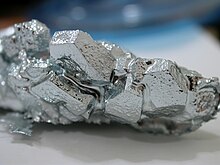Gallium, 31 Ga Pronunciation (GAL -ee-əm Appearance silvery blue [ 1]
Atomic number (Z ) 31 Group group 13 (boron group) Period period 4 Block p-block Electron configuration [Ar ] 3d10 4s2 4p1 Electrons per shell 2, 8, 18, 3 Phase at STP solid Melting point 302.9146 K (29.7646 °C, 85.5763 °F) Boiling point 2673 K (2400 °C, 4352 °F)[ 2] Density (near r.t. ) 5.91 g/cm3 when liquid (at m.p. ) 6.095 g/cm3 Heat of fusion 5.59 kJ/mol Heat of vaporization 256 kJ/mol[ 2] Molar heat capacity 25.86 J/(mol·K) Vapor pressure
P (Pa)
1
10
100
1 k
10 k
100 k
at T (K)
1310
1448
1620
1838
2125
2518
Oxidation states −5, −4, −3,[ 3] +3 [ 4] amphoteric oxide) Electronegativity Pauling scale: 1.81 Ionization energies 1st: 578.8 kJ/mol 2nd: 1979.3 kJ/mol 3rd: 2963 kJ/mol (more ) Atomic radius empirical: 135 pm Covalent radius 122±3 pm Van der Waals radius 187 pm Spectral lines of galliumNatural occurrence primordial Crystal structure orthorhombic Speed of sound thin rod 2740 m/s (at 20 °C) Thermal expansion 18 µm/(m⋅K) (at 25 °C) Thermal conductivity 40.6 W/(m⋅K) Electrical resistivity 270 nΩ⋅m (at 20 °C) Magnetic ordering diamagnetic Molar magnetic susceptibility × 10−6 3 /mol (at 290 K)[ 5] Young's modulus 9.8 GPa Poisson ratio 0.47 Mohs hardness 1.5 Brinell hardness 56.8–68.7 MPa CAS Number 7440-55-3 Naming after Gallia Prediction Dmitri Mendeleev (1871) Discovery and first isolationLecoq de Boisbaudran (1875)
Category: Gallium references
Crystals of gallium joined togetherGallium (chemical symbol: Ga ) is element 31 on the periodic table . It is a soft, gray metal that is rare on Earth. It can easily be melted just by holding it in your hand, as its melting point is very low 29.76 Celsius (85.58 Fahrenheit), however it also sticks to your hand a lot, unlike Mercury . Gallium is a semiconductor , and as the compound Gallium arsenide it is used in electronics and LEDs . Then, Gallium is also used in mirrors . Gallium can also be alloyed with Indium and Tin to create Galinstan . Gallium is similar to the elements Aluminium , Indium and Mercury.[ 7]
Gallium's existence was predicted by Dmitri Mendeleev in 1871. Four years later, it was discovered by Paul-Émile Lecoq de Boisbaudran .[ 7]
↑ "Standard Atomic Weights: Gallium" . CIAAW . 1987.↑ 2.0 2.1 Zhang Y; Evans JRG; Zhang S (2011). "Corrected Values for Boiling Points and Enthalpies of Vaporization of Elements in Handbooks" . J. Chem. Eng. Data . 56 (2): 328–337. doi :10.1021/je1011086 . ↑ Ga(−3) has been observed in LaGa, see Dürr, Ines; Bauer, Britta; Röhr, Caroline (2011). "Lanthan-Triel/Tetrel-ide La(Al,Ga)x 1-x . Experimentelle und theoretische Studien zur Stabilität intermetallischer 1:1-Phasen" (PDF) . Z. Naturforsch. (in German). 66b : 1107–1121.
↑ Hofmann, Patrick (1997). Colture. Ein Programm zur interaktiven Visualisierung von Festkörperstrukturen sowie Synthese, Struktur und Eigenschaften von binären und ternären Alkali- und Erdalkalimetallgalliden (PDF) (Thesis) (in German). PhD Thesis, ETH Zurich. p. 72. doi :10.3929/ethz-a-001859893 . hdl :20.500.11850/143357 . ISBN 978-3728125972 ↑ Weast, Robert (1984). CRC, Handbook of Chemistry and Physics . Boca Raton, Florida: Chemical Rubber Company Publishing. pp. E110. ISBN 0-8493-0464-4 ↑ Kondev, F. G.; Wang, M.; Huang, W. J.; Naimi, S.; Audi, G. (2021). "The NUBASE2020 evaluation of nuclear properties" (PDF) . Chinese Physics C . 45 (3): 030001. doi :10.1088/1674-1137/abddae . ↑ 7.0 7.1 "Gallium | Uses, Properties, & Facts | Britannica" . www.britannica.com . 2024-04-23. Retrieved 2024-05-18 .






